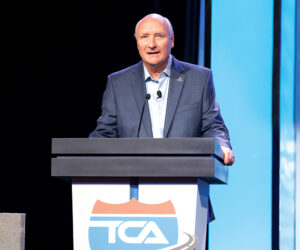The latest, and hopefully most successful, initiative to at last increase truck-parking capacity is the bipartisan bill known as the Truck Parking Safety Improvement Act.
The bill, H.R. 6104, is the work of House Transportation and Infrastructure Committee members Reps. Mike Bost (R-IL) and Angie Craig (D-MN). The bill would dedicate $755 million over five years to increase truck-parking spaces so truck drivers can safely comply with hours-of-service regulations.
The legislation proposes constructing new truck-parking facilities and converting existing weigh stations and rest areas to include functional parking spaces for truck drivers. Funding would be awarded on a competitive basis, and applicants would be required to submit detailed proposals to the U.S. Department of Transportation.
Governmental efforts to improve truck parking date back at least to 2005 when Congress, as part of the Safe, Accountable, Flexible, Efficient Transportation Equity Act: A Legacy for Users (SAFETEA-LU), authorized a $25 million pilot program to study and resolve truck-parking concerns.
That program, which appears to have had very limited positive outcomes, was discontinued in 2012 when Congress passed Jason’s Law as part of the Moving Ahead for Progress in the 21st Century Act (MAP-21). The law was named after Jason Rivenburg, a truck driver who was murdered on March 5, 2009, while parked at an abandoned gas station. He had arrived early for a scheduled delivery at a supermarket in Orangeburg, South Carolina, and was refused overnight parking to wait and unload the following morning.
Through the persistent efforts of Rivenburg’s wife, Hope, Sen. Chuck Schumer, (D-NY) first introduced a Jason’s Law bill in 2009, but the bill never made it out of committee.
Hope Rivenburg and Schumer persisted, and in 2012, Jason’s Law became part of MAP-21.
While Jason’s Law encouraged the construction of new truck-parking facilities and the use of existing facilities for truck parking, including inspection and weigh stations, extremely limited funding was provided through MAP-21 for the implementation of the law.
Craig and Bost sounded positive notes when the Truck Parking Safety Improvement Act was introduced.
“Right now, there is a lack of places for truck drivers to safely stop, forcing them to pull over to the side of the road, or continue driving, both of which are risky,” said Craig.
Bost, who said he “grew up” in a family trucking business, is no stranger to the rewards and pitfalls of the industry.
“I learned at early age what a rewarding career [trucking] could be,” said Bost. “However, I also understood that trucking can be a tough, demanding and even dangerous job. One concern for truck drivers is the lack of enough safe parking spots where they can get the rest they need without risking collisions on the shoulder of the highway or being forced to push their limits to find the next rest stop. This puts the truckers and other motorists at significant risk.”
Truckload Carriers Association Vice President of Government Affairs David Heller is among the trucking industry stakeholders who are optimistic about the bill’s passage, including the funding.
“Looking at the plethora of bills that have seemingly been introduced lately, H.R. 6104 certainly fits the mold of something that actually could and should move,” said Heller. “First and foremost, it is sensible. In today’s trucking environment, parking is at a premium. Burdened with hours-of-service regulations based on an environment that no longer exists, our drivers need the opportunity for safe and secure parking to obtain sufficient rest.”
The bill, he added, makes sense for all involved, including trucking and safety groups. The bill is also timely, he said.
“As we make our way out of the COVID-19 pandemic, the one thing that certainly affected the efficient delivery of emergency supplies was the lack of adequate parking and driver facilities. This bill would go a long way toward preventing that in the future,” added Heller.
While the $755 million would only put a dent in creating the needed spaces, D.M. Bowman President and CEO and First Vice Chairman of TCA Jim Ward said it’s a start.
“The level of funding, used appropriately, is a good starting point to address some of the critical locations lacking adequate parking space for drivers,” he said.
“Adequate is the optimum word,” said NATSO Vice President of Government Affairs David Fialkov. NATSO represents travel-plaza and truck-stop owners and operators, who manage 90% of the truck-parking spaces available in the U.S.
“Truck-parking availability is not a problem in most parts of the country at most times of day,” he said.
There are, he noted, hot spots where availability is low because the price of land is prohibitively high or areas — mostly high-volume metropolitan areas — where hundreds of drivers tend to stop to stage deliveries for the next day.
While the $755 million is a start, trucking stakeholders are hoping that the federal government is in a sharing mentality if the bill passes and is fully funded.
“It is currently within every state department of transportation’s prerogative to fund additional truck-parking capacity with existing federal dollars,” added NATSO Vice President of Public Affairs Tiffany Wlazlowski Neuman, noting the average cost of a new parking space at a private facility is $10,000. “NATSO also has long advocated for the federal and state departments of transportation to remove barriers to private sector investment in truck-parking capacity.”
“I believe the private truck-stop business needs to be involved, because it’s their core competency,” said D.M. Bowman’s Ward. “They know what needs to be done and how best to execute this service that most effectively meets the commercial driver’s needs.”
NATSO’s Fialkov urged the trucking industry to refrain from using a shotgun approach when developing new capacity.
“Efforts to expand truck parking should explicitly target areas where we know there is a serious problem,” he said.
NATSO has another potential solution to the sometime shortage of spaces.
“We’ve long maintained that the best way to address any truck-parking capacity concerns is for motor carriers to negotiate truck parking in their contractual relationships with truck stops and travel plazas like they negotiate for fuel,” Neuman said.
Solving the capacity issue will require public and private entities working together, she noted.
“The travel-center industry spends considerable resources working with the Federal Department of Transportation and dozens of state and local governments to help address their concerns surrounding truck-parking availability,” added Neuman. “Yet one of the biggest challenges faced by the truck-stop and travel-plaza industry in expanding or building truck-parking capacity is oftentimes local governments and local community opposition.”
TCA’s Heller called truck-parking capacity a “critical safety obstacle.”
“Truck parking consistently ranks as one of the most important issues for the Truckload Carriers Association and trucking stakeholders across the country,” Heller stated. “On a daily basis, our companies’ drivers face dangerous conditions because of the lack of safe and convenient parking options.”
Whether the Truck Parking Safety Improvement Act will be the catalyst to a resolution to truck parking capacity remains to be seen.
The industry “hopes” that it will.
Lyndon Finney’s publishing career spans over 55 years beginning with a reporter position with the Southwest Times Record in Fort Smith, Arkansas, in 1965. Since then he’s been a newspaper editor at the Southwest Times Record, served five years as assistant managing editor of the Arkansas Democrat-Gazette in Little Rock and from November 2004 through December 2019 served as editor of The Trucker. Between newspaper jobs he spent 14 years as director of communications at Baptist Health, Arkansas’ largest healthcare system. In addition to his publishing career he served for 46 years as organist at Little Rock’s largest Baptist church.








